Indoor tracking, also referred to as indoor positioning, uses a network of devices to locate people and objects usually within a building where GPS would fail entirely or lack precision. Most indoor tracking systems use WiFi, Bluetooth, or ultra-wideband technology. Indoor tracking is often one of the most helpful features of a smart environment or smart building and requires technologies which can work together with an IoT platform. This article will walk through indoor tracking and positioning use cases, benefits, technology, and the advantages of using these systems with an IoT platform.
Indoor Tracking Use Cases and Benefits
Smart Office and Smart Building
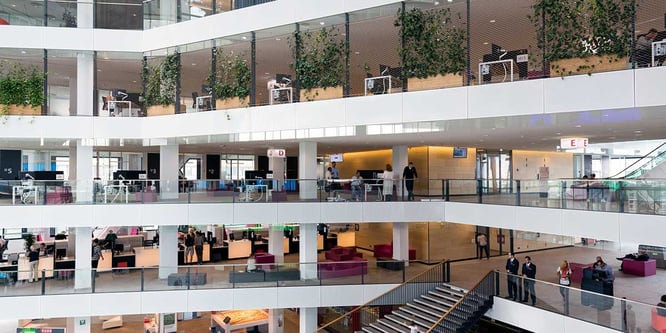
Indoor tracking in a smart environment can lead to many benefits. The tracking of shared assets such as whiteboard carts, computers, bikes, or toolboxes help people spend less time looking for assets. Indoor tracking of these items also helps ensure that assets are being utilized efficiently and that data is available to justify buying additional assets if necessary.
Within smart environments, hot desking is becoming more and more popular. With indoor tracking, available hot desks can easily be visualized and found. Tracking technology can also make finding an employee easier.
Security
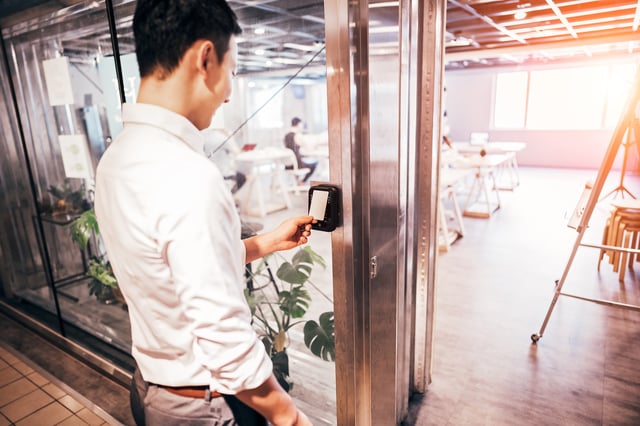
Indoor tracking can also provide security benefits. If an employee or guest enters an area they are not authorized to be in, an alert can be sent to security notifying them of this event.
Indoor tracking also helps with the lone worker scenario where a worker is by him or herself performing a high-risk task (i.e. working in a machine shop or working out in the company gym). Security can remotely monitor an employees' safety or can dispatch a team member to watch over the employee.
High value asset tracking with technology can ensure that a security team is alerted if an R&D product or piece of expensive equipment leaves a predefined area.
In the case of an emergency such as a fire, tornado, or an active shooter, security teams can quickly determine if everyone has made it to the designated safe area. Conversely, they can also determine exactly where an employee or guest is if they are in an unsafe area during the emergency.
Airports
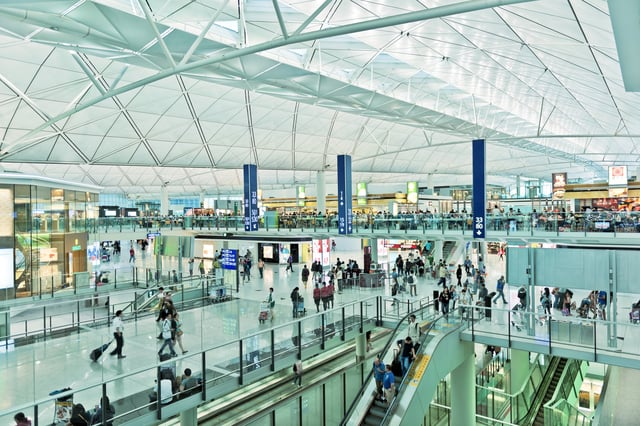
Indoor tracking can also be used in airports to help provide a better experience for travelers. This can include monitoring security line times and documenting the length of time people are waiting at gates. An airport can use the data collected to introduce changes to improve security line times or compare the before and after dwell times to determine the impact of the change.
Indoor tracking of travelers can also show traffic patterns and which paths have the most traffic. They can offer premium positioning to restaurants and advertisers based on the high traffic path data.
Airports can track the location of facility team members as well. If a sensor or traveler reports that a garbage can is full or hand towels in the bathroom are out, an alert can be sent to dispatch the closest team member to empty the garbage can or refill the hand towels.
Airports can also track assets throughout the airport such as wheelchairs. This can ensure that they have enough wheelchairs at any given time and that the wheelchairs are in the correct location at the correct time, such as at a specific gate for an arriving traveler who may need a wheelchair.
Hospitals
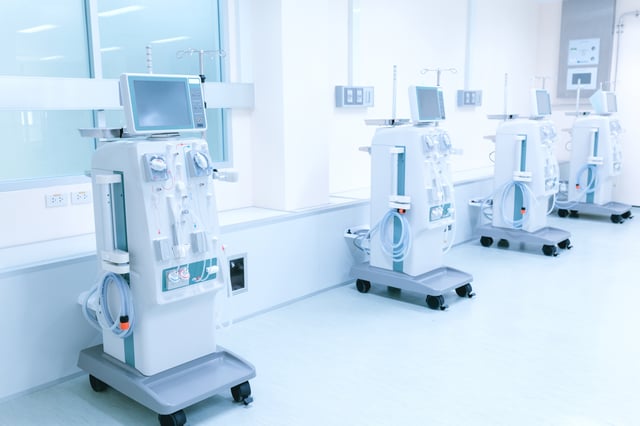
Tracking of hospital equipment, such as wheelchairs, nurse carts, and glucose monitors, is extremely important and crucial for the well-being and safety of the hospital’s patients. Using indoor tracking can help nurses and doctors quickly find the equipment to better serve their patients. This data also helps management determine if they have enough equipment per hospital or per floor. Staff can quickly learn whether extras should be purchased or that the correct amount is distributed properly throughout the hospital. Tracking this equipment also helps IT and maintenance teams find the equipment to ensure calibration is up to date and that the hospital is staying within compliance for maintenance activities.
In hospitals, indoor tracking technologies can also be used to locate nurses, doctors, and even patients. This ensures that patients are always where they should be and that enough nurses and doctors are always where they need to be to serve their patients and help in patient emergencies.
Indoor Tracking Hardware and Technology
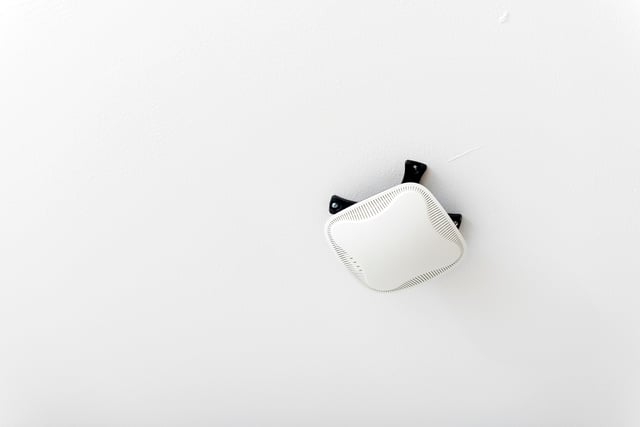
There are a lot of different hardware and technology options for indoor tracking. When determining which technology to use, there is usually a compromise between cost and precision. Let’s take a look at some of the hardware and technology used with indoor tracking.
WiFi Signal
By using a WiFi signal, an access point can track an asset or person by the MAC address of any device that supports WiFi such as a phone, computer, or tablet. This technology monitors signal strength from different access points to determine where that person or asset is. This method of indoor tracking can have a range of up to 150 meters and provides an accuracy of usually around five meters but can go as high as 15 meters.
Inpixon makes hardware that can be used for WiFi indoor tracking.
Bluetooth
A Bluetooth beacon or an access point that has Bluetooth enabled can track Bluetooth devices such as phones, computers, tablets, and Bluetooth tags. This technology is like WiFi where it uses signal strength to determine position. It usually has a range of around 25 meters and has an accuracy typically around three to five meters. Losant partner, Aruba Meridian provides an access point with Bluetooth tracking capabilities.
Ultra-Wideband
Ultra-wideband uses radio frequencies from 500 MHz up to a couple of GHz which are much higher frequencies than WiFi or Bluetooth. This gives a shorter overall range but keeps the ultra-wideband frequencies from interfering with the lower band frequencies.
This technology uses short pulse transmissions with steep rises and drops. This helps determine the start and stop signals to accurately measure the distance between two devices. The accuracy of an indoor tracking system using ultra-wideband is typically within 10cm.
Decawave provides ultra-wideband hardware to deliver very precise indoor tracking solutions.
Behavior
It is also possible to track assets and people using a behavior-based approach. Some companies have implemented hot desking by monitoring phones plugged into charging stations on a desk or with docking stations for computers. When the system sees one of these assets are in use it then updates the system to show that a desk is currently occupied.
Another example of this is in a use case for stadium seat tracking. Losant recently installed accelerometers on seats within a suite at the Western & Southern Open. When the seat went from vertical to horizontal it would update the dashboard to show someone was located at that seat and when it went back to vertical, the dashboard was updated to show that the seat was no longer occupied. This solution ultimately tracked people and where they were within the suite. The dashboard below shows this indoor tracking solution. You can read more about it in the Using IoT to Deliver Smart Stadium Insights blog.
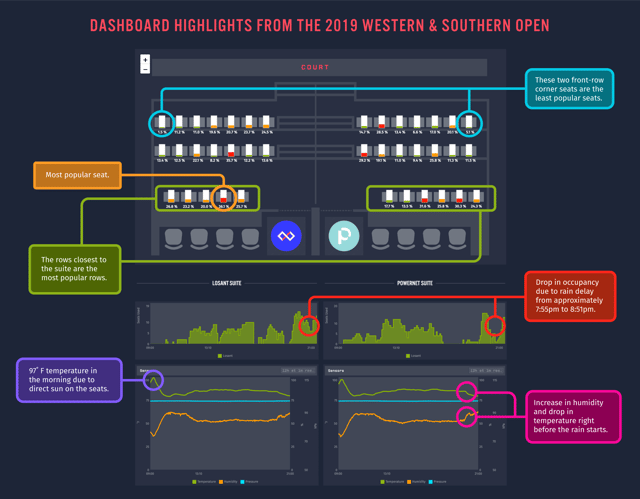
Benefits of Using an IoT Platform With Indoor Tracking
Most of these indoor tracking systems provide a dashboard to display where an asset is on a map. This data is much more powerful when used with an IoT platform.
![]()
An IoT platform provides abstraction from the underlying hardware and protocols being used within these indoor tracking systems. Once the data is abstracted into an IoT platform, it can then be normalized with many other data sources, such as an ERP system in manufacturing, an EHR/EMR system for hospitals, BMS for smart buildings or smart offices, or a CRM system in retail or banking. This normalized data from many data sources can then be exported or used within the IoT platform to help orchestrate other actions, such as alerting the closest facilities team member that hand towels need to be replaced in a specific bathroom and updating the inventory management system.
An IoT platform can also provide many other benefits as well, such as data storage, historical replay or analysis, analytics, batch processing, and reporting.
Losant is seeing more and more customers using the Losant Enterprise IoT Platform to help extend indoor tracking systems to achieve the benefits listed above. If you'd like to learn more about how Losant and our partners can help improve your smart environment with indoor tracking, please contact us to schedule a call with one of our solution experts.
